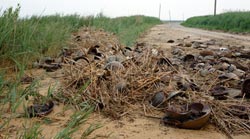Climate change affects horseshoe crab numbers

Hoards of horseshoe crabs stranded in Port Mahon, Delaware Bay, USA. Rocks placed along the beach to protect the coast are preventing the crabs from returning to their playgrounds. Photograph: Peter Funch<br>
However, climatic changes may also play a role. Researchers from the University of Gothenburg reveal how sensitive horseshoe crab populations are to natural climate change in a study recently published in the scientific journal Molecular Ecology.
The horseshoe crab is often regarded as a living fossil, in that it has survived almost unchanged in terms of body design and lifestyle for more than 400 million years. Crabs similar to today’s horseshoe crabs were walking the Earth long before the dinosaurs.
“Examining the genetic variation in populations of horseshoe crabs along the east coast of America has enabled us to track changes in population size over time,” says Matthias Obst from the Department of Zoology at the University of Gothenburg, one of the authors of the study published in Molecular Ecology. “We noted a clear drop in the number of horseshoe crabs at the end of the Ice Age, a period characterised by significant global warming.”
Horseshoe crab important in the coastal food chain
“Our results also show that future climate change may further reduce the already vastly diminished population. Normally, horseshoe crabs would have no problem coping with climate change, but the ongoing destruction of their habitats make them much more sensitive.”
Horseshoe crabs are an important part of the coastal food chain. Their blue blood is used to clinically detect toxins and bacteria. There are currently just four species of horseshoe crab left: one in North America (Limulus polyphemus) and three in South East Asia (Carcinoscorpius rotundicauda, Tachypleus gigas and Tachypleus tridentatus).
All four species are under threat on account of over-harvesting for use as fish bait and in the pharmaceuticals industry. The destruction of habitats around the beaches that are the crabs’ breeding grounds has also contributed to the drop in numbers.
“The most decisive factor may be future changes in sea level and water temperature,” says Obst. “Even if they are on a minimal scale such changes are likely to have a negative impact on the crabs’ distribution and reproduction.”
See them in Gothenburg
Living horseshoe crabs can be seen at the Maritime Museum in Gothenburg.
Link to the article in Molecular Ecology http://onlinelibrary.wiley.com/doi/10.1111/j.1365-
294X.2010.04732.x/abstract
For more information, please contact:
Matthias Obst, Department of Zoology at the University of Gothenburg
Telephone: +46 31- 786 3662
Mobile: +46 738- 475 003
Bibliographic data:
Journal: Molecular Ecology 25 JUN 2010
Title: Population dynamics of American horseshoe crabs—historic climatic events and recent anthropogenic pressures
Authors: Søren Faurby, Tim L. King, Matthias Obst, Eric M. Hallerman, Cino Pertoldi, Peter Funchz
DOI: 10.1111/j.1365-294X.2010.04732.x
matthias.obst@zool.gu.se
Media Contact
All latest news from the category: Ecology, The Environment and Conservation
This complex theme deals primarily with interactions between organisms and the environmental factors that impact them, but to a greater extent between individual inanimate environmental factors.
innovations-report offers informative reports and articles on topics such as climate protection, landscape conservation, ecological systems, wildlife and nature parks and ecosystem efficiency and balance.
Newest articles

Silicon Carbide Innovation Alliance to drive industrial-scale semiconductor work
Known for its ability to withstand extreme environments and high voltages, silicon carbide (SiC) is a semiconducting material made up of silicon and carbon atoms arranged into crystals that is…

New SPECT/CT technique shows impressive biomarker identification
…offers increased access for prostate cancer patients. A novel SPECT/CT acquisition method can accurately detect radiopharmaceutical biodistribution in a convenient manner for prostate cancer patients, opening the door for more…

How 3D printers can give robots a soft touch
Soft skin coverings and touch sensors have emerged as a promising feature for robots that are both safer and more intuitive for human interaction, but they are expensive and difficult…





















